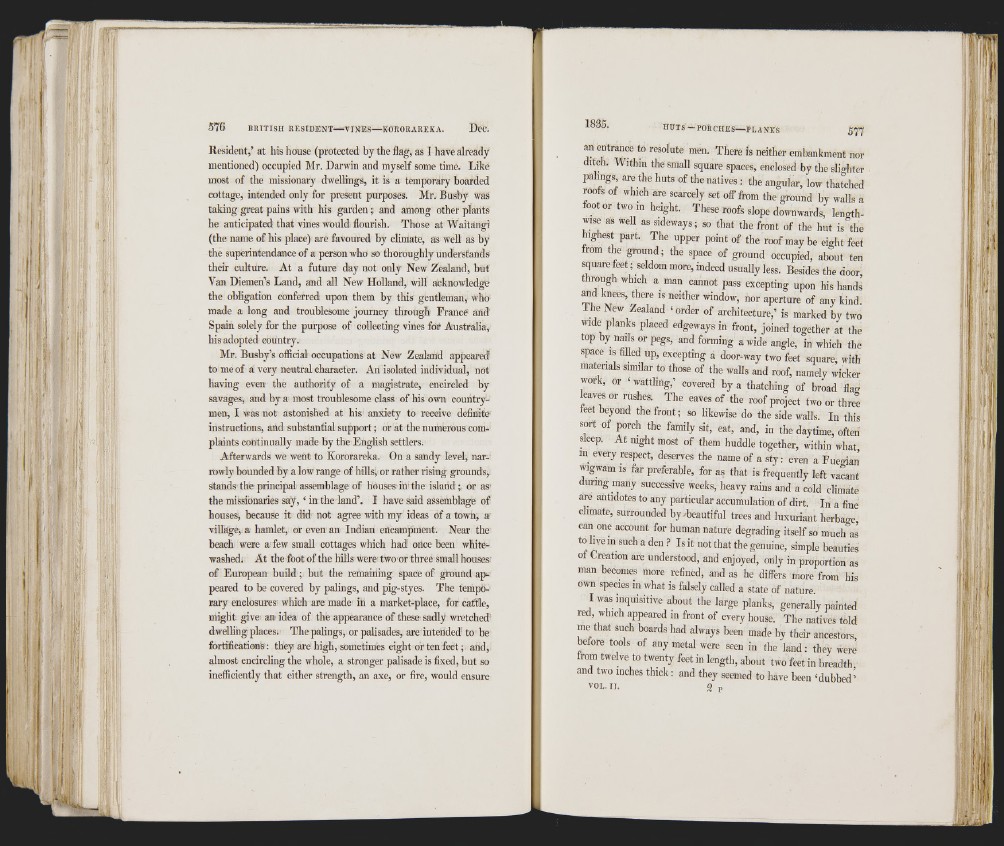
M i «
576 BRITISH RES IDENT VINES KORORAREKA. Dec.
Resident,’ at his house (protected by the flag, as I have already
mentioned) occupied Mr. Darwin and myself some time. Like
most of the missionary dwellings, it is a temporary boarded
cottage, intended only for present purposes. Mr. Busby was
taking great pains with his garden; and among other plants
he anticipated that vines would flourish. Those at Waitangi
(the name of his place) are favoured by climate, as well as by
the superintendance of a person who so thoroughly understands
their culture. At a future day not only New Zealand, but
Van Diemen’s Land, and all New Holland, will acknowledge
the obligation conferred upon them by this gentleman, who
made a long and troublesome journey through France and
Spain solely for the purpose of collecting vines for Australia,
his adopted country.
Mr. Busby’s official occupations at New Zealand appeared
to me of a very neutral character. An isolated individual, not
having even the authority of a magistrate, encircled by
savages, and by a most troublesome class of his own countrymen,
I was not astonished at his anxiety to receive definite
instructions, and substantial support; or at the numerous complaints
continually made by the English settlers.
Afterwards we went to Kororareka. On a sandy level, narrowly
bounded by a low range of hills, or rather rising grounds,
stands the principal assemblage of houses in the island; or as
the missionaries say, ‘ in the land’. I have said assemblage of
houses, because it did not agree with my ideas of a town, a
village, a hamlet, or even an Indian encampment. Near the
beach were a few small cottages which had once been whitewashed.
At the foot of the hills were two or three small houses
of European build; but the remaining space of ground appeared
to be covered by palings, and pig-styes. The temporary
enclosures which are made in a market-place, for caftle,
might give an idea of the appearance of these sadly wretched
dwelling places. The palings, or palisades, are intended to be
fortifications: they are high, sometimes eight or ten feet; and,
almost encircling the whole, a stronger palisade is fixed, but so
inefficiently that either strength, an axe, or fire, would ensure
1835. HUTS - P O R C H E S— PLANKS 577
an entrance to resolute men. There is neither embankment nor
ditch. Within the small square spaces, enclosed by the slighter
pahngs are the huts of the natives : the angular, low thatched
roofs of whmh are scarcely set off from the ground by walls a
foot or two m height. These roofs slope downwards, lengthwise
as well as sideways; so that the front of the hut is the
highest part. The upper point of the roof may be eight feet
rom t e ground; the space of ground occupied, about ten
square feet; seldom more, indeed usually less. Besides the door,
through which a man cannot pass excepting upon his hands
md knees, there is neither window, nor aperture of any kind.
The New Zealand ‘ order of architecture,’ is marked by two
vnde planks placed edgeways in front, joined together at the
top by nails or pegs, and forming a wide angle, in which the
space IS filled up, excepting a door-way two feet square, with
materials similar to those of the waUs and roof, namely wicker
work, or ‘ watthng,’ covered by a thatching of broad flag
leaves or rushes. The eaves of the roof project two or three
feet beyond the front; so likewise do the side walls. In this
sort of porch the family sit, eat, and, in the daytime, often
Meep. At night most of them huddle together, within what
m every respect, deserves the name of a sty: even a Fuegian
wigwam IS far preferable, for as that is frequently left vacant
during many successive weeks, heavy rains and a cold climate
are antidotes to any particular accumulation of dirt. In a fine
chmate, surrounded by-beautiful trees and luxuriant herbare,
can one account for human nature degrading itself so muclMas
to live in such a den .? Is it not that the genuine, simple beauties
of Creation are understood, and enjoyed, only in proportion as
man becomes more refined, and as he differs more from his
own species in what is falsely called a state of nature
I was inquisitive about the large planks, generally painted
red, which appeared in front of every house. The natives told
me that such boards had always been made by their ancestors,
belore tools of any metal were seen in the land: they were
from twelve to twenty feet in lengtli, about two feet in breadth
and two inches thick : and they seemed to have been ‘dubbed’
VOL. I I . g p
(I
ll
I 1
< t , ...
jji
I .1